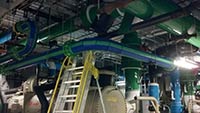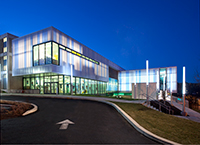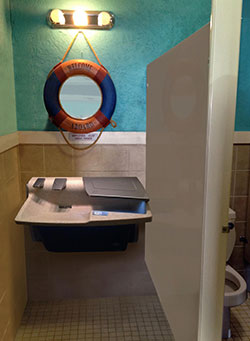view all Case Studies
Piping System Delivers Comfort to Historic Medical School

The comfort of staff, students and faculty is a primary concern at facilities of higher education. One especially tough challenge for maintenance and engineering managers in this area is maintaining comfortable room temperatures.
May 12, 2014 -
HVAC
The comfort of staff, students and faculty is a primary concern at facilities of higher education. One especially tough challenge for maintenance and engineering managers in this area is maintaining comfortable room temperatures.
Harvard Medical School in Boston is synonymous with excellence in education, research, and clinical care for generations. The university’s mix of old and new facilities presented the facility management staff with the need for mechanical systems upgrades.
The five-story, 72,877-square-foot Gordon Hall administration building, opened in 1905, has undergone multiple renovations since 1927. It is the main administration building and houses the offices of the medical school dean, associate deans, and department heads.
Rob Behrent, the medical school’s facilities engineer, was searching for a better pipe solution for the administration building and about 20 other buildings he oversees. In early 2013, Behrent and his team were working on the plans replacing split DX air-conditioning units involving fan-coil units at the administration building.
“Gordon Hall was a problem because there was a lot of external corrosion on the pipes and you don’t want leaks,” Behrent says. “If it leaks, it leaks on the dean of the medical school. Some copper piping installations also exhibited similar problems with joint leaks. In addition, during colder outside temperatures, people leave windows open, and the copper freezes and leaks.”
Behrent learned of Aquatherm’s polypropylene-random (PP-R) pipe systems when his supervisor read a trade magazine article about them.
“We were initially going to use CPVC (chlorinated polyvinyl chloride), but after much consideration, the cold-resistant characteristics and seismic capabilities of Aquatherm piping were driving factors in the decision,” Behrent says. “CPVC can get brittle and offers very little seismic capability, compared to Aquatherm.”
After a half-day of training on the piping system, Behrent’s team installed about 200 feet of ½-2-inch Green Pipe® between the mechanical room and the new fan-coil units on the second floor to provide heating and cooling to the office spaces.
“We wanted to replace all existing pipe at some point, and this job also doubled as a proof of concept and technology,” Behrent says. “In Gordon Hall, we had so many leaks that we want to completely re-pipe the system. Due to leaks, a re-pipe of the entire building’s HVAC system is planned and in the budgeting process.”
Next
Read next on FacilitiesNet












